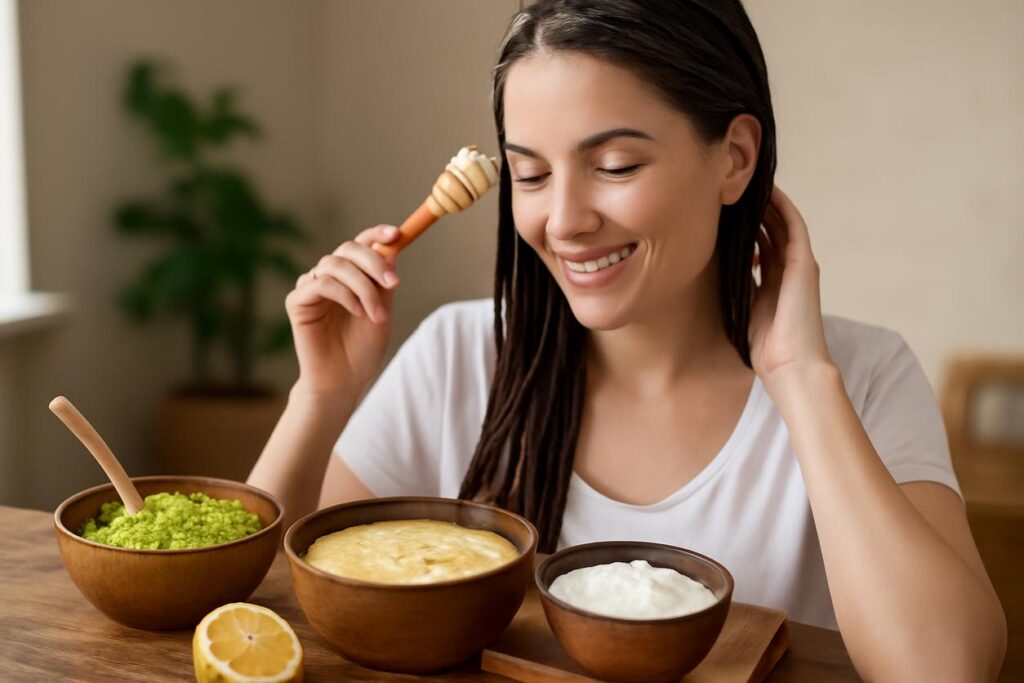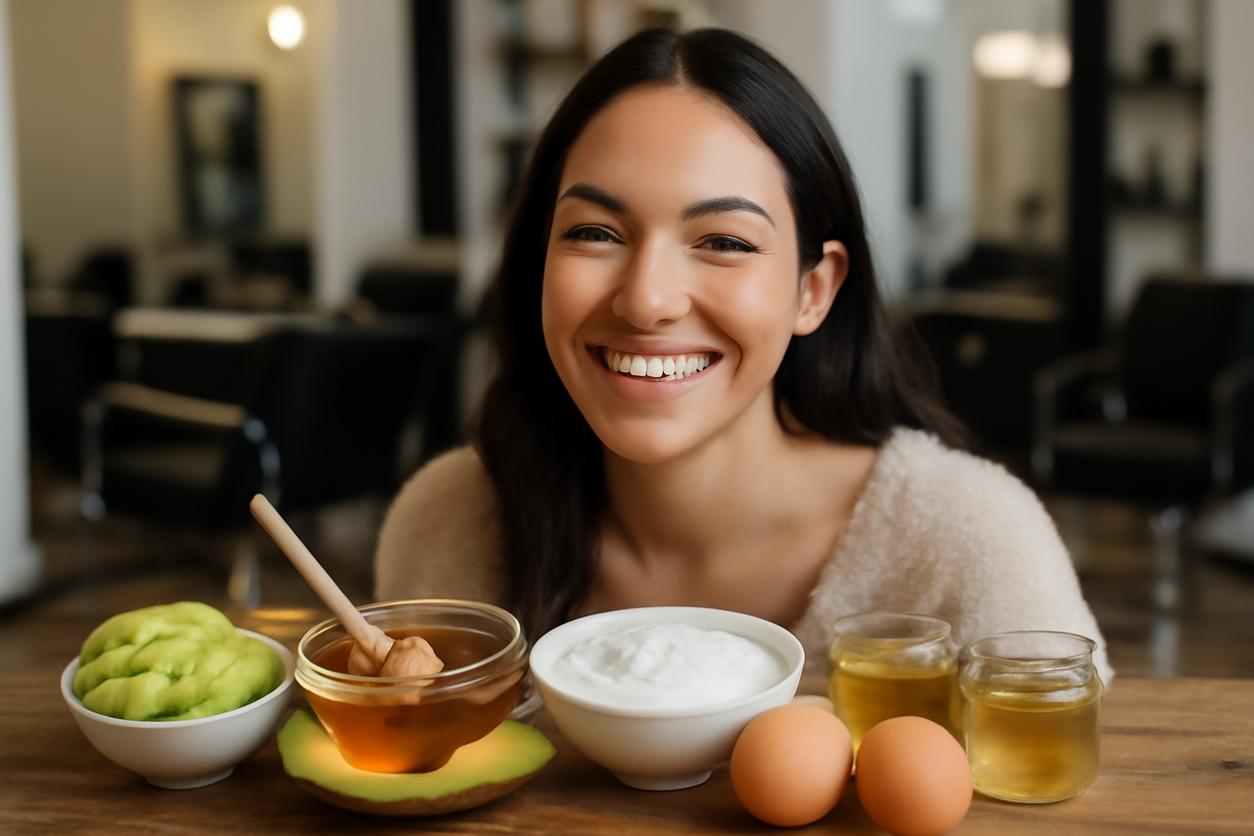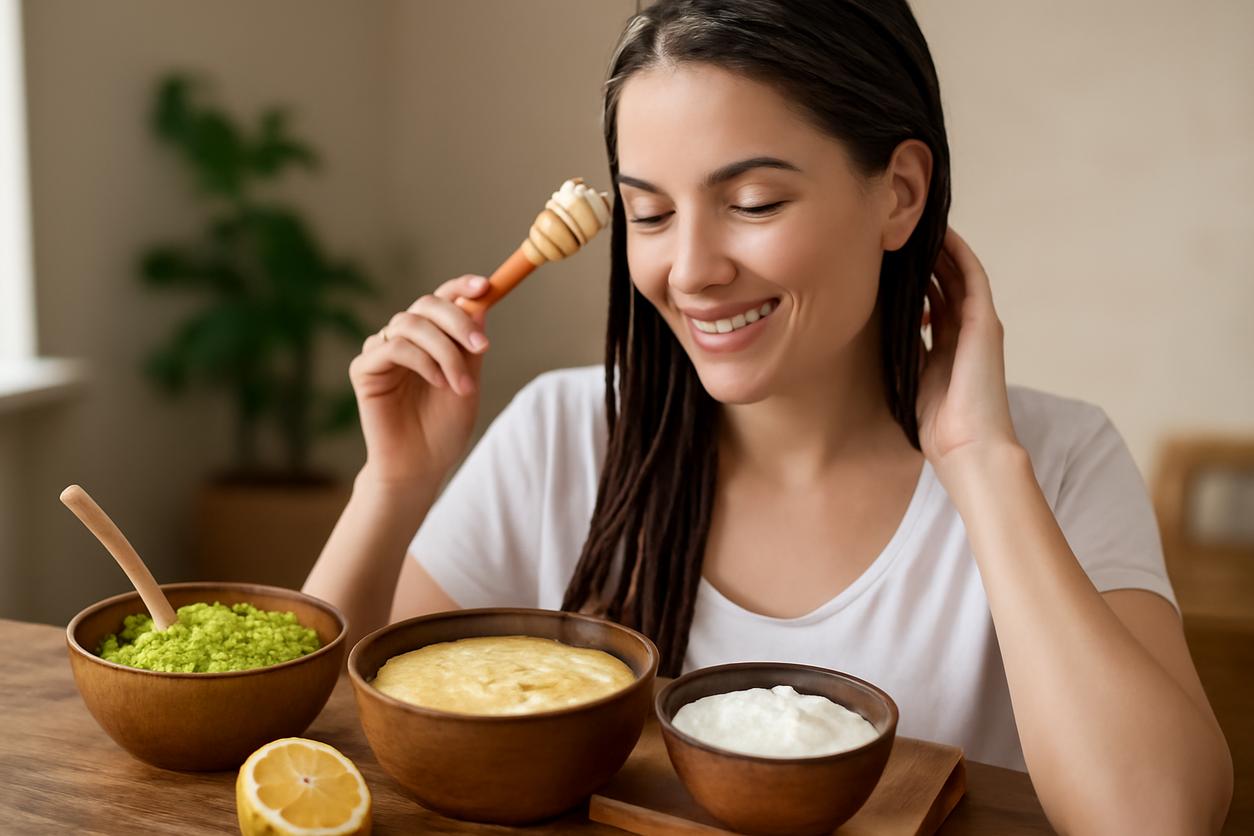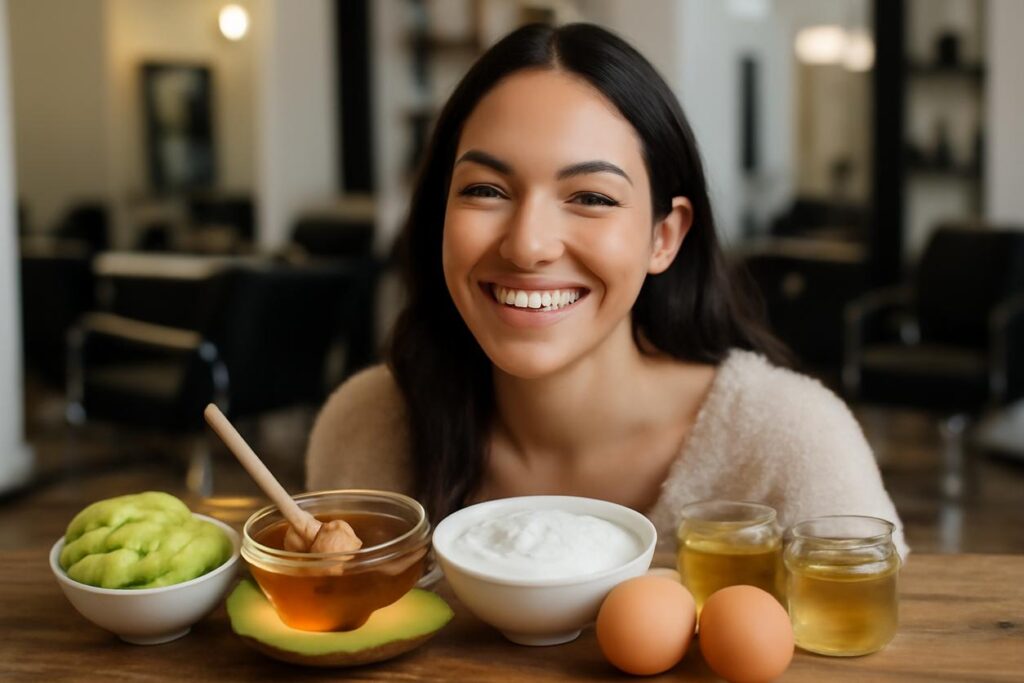Your Ultimate Guide to the Perfect DIY Hair Mask: Recipes and Science for 2025
Welcome to the world of homemade hair care! If you’ve ever looked at your hair and wished for more shine, strength, or moisture, the answer might be waiting in your kitchen. A DIY hair mask is a powerful, cost-effective, and natural way to give your locks the targeted nourishment they crave. Unlike many store-bought treatments, creating your own mask gives you complete control over the ingredients, ensuring you’re only using what’s best for your specific hair type and goals. This guide will walk you through the science behind common kitchen ingredients, provide adaptable recipes, and offer expert tips to help you master the art of the homemade hair mask.
Table of Contents
- The Science of Common Ingredients: Proteins, Oils, and Humectants
- How to Pick a Mask for Your Hair Type
- Eight Simple Kitchen DIY Hair Masks and Their Benefits
- Application Method, Timing and Tools
- Safety First: Patch Tests and Allergy Notes
- How Often to Use Masks and How to Fit Them into Your Routine
- Ingredient Substitutions and Budget Friendly Swaps
- Troubleshooting: When a Mask Makes Hair Greasy or Dry
- Quick FAQ: Questions Readers Ask Most
- References and Further Reading
The Science of Common Ingredients: Proteins, Oils, and Humectants
Understanding what makes a DIY hair mask effective starts with understanding its core components. The magic lies in three key categories of ingredients that work together to repair, moisturize, and protect your hair strands. According to hair nutrition research, topical application of certain nutrients can significantly improve hair health.
Proteins for Strength
Your hair is primarily made of a protein called keratin. When hair becomes damaged from heat, styling, or environmental factors, its protein structure weakens. Ingredients rich in amino acids—the building blocks of protein—can help fill in these gaps and temporarily strengthen the hair shaft.
- Common Sources: Yogurt, eggs, gelatin, avocado.
- Best For: High-porosity, chemically treated, or brittle hair.
- How They Work: Small protein molecules patch up the hair’s cuticle, reducing breakage and improving elasticity.
Oils for Sealing
Oils are emollients, meaning they smooth and soften the hair cuticle. They are fantastic at sealing in moisture that is already present in the hair, preventing it from escaping and leaving your hair dry. They also add shine and reduce frizz by creating a protective barrier.
- Common Sources: Coconut oil, olive oil, avocado oil, jojoba oil.
- Best For: Dry, coarse, or frizzy hair.
- How They Work: These oils coat the hair strand, locking in hydration and smoothing down the outer cuticle layer for a sleeker appearance.
Humectants for Hydration
Humectants are ingredients that attract water from the atmosphere and draw it into the hair shaft. This action provides a direct infusion of moisture, making them essential for combating dryness and dehydration.
- Common Sources: Honey, aloe vera, glycerin, agave nectar.
- Best For: All hair types, especially dry and low-porosity hair.
- How They Work: By pulling in moisture, humectants help to hydrate the hair from the inside out, improving its softness and flexibility.
How to Pick a DIY Hair Mask for Your Hair Type
Not all hair is created equal, and your perfect DIY hair mask should be tailored to your unique needs. Choosing the right ingredients is key to achieving your desired results without weighing your hair down or leaving it feeling greasy.
Fine or Oily Hair: Lightweight Options and Application Tips
If your hair gets greasy easily or is very fine, heavy oils and butters are not your friends. Opt for lightweight hydrators and clarifying ingredients. Focus application on the mid-lengths and ends, avoiding the scalp.
- Best Ingredients: Aloe vera, honey, chamomile tea, clay (like bentonite or kaolin), and light oils like grapeseed or jojoba.
- Goal: To hydrate and nourish without adding weight or buildup.
Dry or Damaged Hair: Deep Repair Formulations
For hair that feels like straw or has visible signs of damage (split ends, breakage), you need a rich, restorative homemade hair mask. Focus on a combination of proteins to rebuild and oils to seal and protect.
- Best Ingredients: Avocado, banana, coconut oil, olive oil, eggs, yogurt.
- Goal: Deeply moisturize, strengthen the hair shaft, and restore shine and softness.
Curly and Coily Hair: Moisture-First Strategies
Curly and coily hair patterns are naturally drier because scalp oils have a harder time traveling down the hair shaft. The priority is always moisture, moisture, and more moisture! Use rich, emollient ingredients and humectants.
- Best Ingredients: Shea butter, mango butter, avocado, banana, honey, olive oil, castor oil.
- Goal: To provide intense hydration, define curl patterns, reduce frizz, and enhance elasticity.
Eight Simple Kitchen DIY Hair Masks and Their Benefits
Ready to get started? Here are some simple, effective recipes you can whip up in minutes. We’ll provide step-by-step instructions for our top four, plus four more quick ideas.
Avocado and Coconut Repair Mask (Step-by-Step)
This is the ultimate DIY hair mask for dry, damaged, or frizzy hair. Avocado is packed with fatty acids and vitamins, while coconut oil penetrates the hair shaft to moisturize from within.
- Ingredients: 1 ripe avocado, 2 tablespoons of coconut oil (melted).
- Preparation: Mash the avocado in a bowl until it’s completely smooth and free of lumps. A blender works best to achieve a creamy consistency.
- Mixing: Stir in the melted coconut oil until the mixture is fully combined.
- Application: Apply to clean, damp hair, focusing on the ends.
- Timing: Leave on for 20-30 minutes. Rinse thoroughly with lukewarm water.
Yogurt and Honey Protein Boost (Step-by-Step)
Perfect for weak or brittle hair, this mask delivers a gentle dose of protein from yogurt and a hydrating boost from honey.
- Ingredients: 1/2 cup of plain, full-fat yogurt, 1 tablespoon of honey.
- Preparation: In a small bowl, combine the yogurt and honey.
- Mixing: Stir until the mixture is smooth and has a consistent texture.
- Application: Apply from roots to ends on damp hair.
- Timing: Let it sit for 15-20 minutes. Rinse well with cool water to avoid “cooking” the yogurt.
Aloe and Chamomile Soothing Mask (Step-by-Step)
This lightweight mask is ideal for fine hair or an irritated scalp. Aloe vera hydrates without adding weight, and chamomile is known for its calming properties.
- Ingredients: 3 tablespoons of pure aloe vera gel, 1/4 cup of strongly brewed (and cooled) chamomile tea.
- Preparation: Brew one chamomile tea bag in 1/4 cup of hot water and let it cool completely.
- Mixing: Whisk the cooled tea and aloe vera gel together. The mixture will be thin, so a spray bottle can be helpful for application.
- Application: Spray or apply to the scalp and hair.
- Timing: Leave on for 20 minutes before rinsing.
Olive Oil and Banana Hydration Mask (Step-by-Step)
A deeply moisturizing treatment for very dry or curly hair. Banana is rich in potassium and natural oils, which help soften hair and improve elasticity.
- Ingredients: 1 ripe banana, 1 tablespoon of olive oil.
- Preparation: Blend the banana until it is a completely smooth puree. This step is crucial to avoid banana chunks in your hair!
- Mixing: Stir in the olive oil until well incorporated.
- Application: Work through damp hair from top to bottom.
- Timing: Cover with a shower cap and leave on for 30 minutes. Rinse very thoroughly.
Four More Quick DIY Hair Mask Ideas
- Egg and Olive Oil: Great for adding shine and strength. (1 egg, 2 tbsp olive oil)
- Pumpkin and Honey: Rich in vitamins A and C for scalp health. (1/2 cup pumpkin puree, 2 tbsp honey)
- Oatmeal and Milk: Soothing for an itchy scalp and gently moisturizing. (1/2 cup cooked oatmeal, 2 tbsp milk)
- Apple Cider Vinegar and Water Rinse: Clarifies and adds shine. (1 part ACV, 3 parts water)
Application Method, Timing and Tools
Getting the most out of your homemade hair mask is all about the technique. For more DIY hair mask tips, you can explore detailed guides from health-focused resources.
- Tools: A bowl for mixing, a spoon or whisk, a hair dye brush for precise application (optional), and a shower cap or plastic wrap to trap heat.
- Preparation: Always apply your mask to clean, towel-dried (damp) hair. This allows the ingredients to penetrate the cuticle more effectively.
- Application: Section your hair and apply the mask evenly, starting from the ends and working your way up. Avoid the roots if you have oily hair.
- Timing: Most masks work best when left on for 20-30 minutes. Leaving a mask on for hours doesn’t necessarily increase its benefits and can sometimes cause over-moisturizing.
- Rinsing: Rinse with lukewarm or cool water. Hot water can strip moisture. Follow up with your regular conditioner to seal the cuticle.
Safety First: Patch Tests and Allergy Notes
Just because an ingredient is natural doesn’t mean it’s right for everyone. Your skin and scalp can be sensitive to foods you have no problem eating. The NHS provides guidance on general hair and scalp health, which underscores the importance of being gentle with your body.
- Perform a Patch Test: Before applying a new DIY hair mask to your entire head, test a small amount on a discreet area of skin, like behind your ear or on your inner elbow.
- Wait 24 Hours: Check for any signs of irritation, such as redness, itching, or swelling. If you experience a reaction, do not use the mask.
- Be Mindful of Allergies: If you have known food allergies, do not apply those ingredients to your hair or scalp.
How Often to Use Masks and How to Fit Them into Your Routine
Consistency is key to seeing results. However, over-masking can lead to product buildup or hygral fatigue (over-moisturizing). A solid hair care strategy for 2025 and beyond is about balance.
- For Dry or Damaged Hair: Use a deep-conditioning DIY hair mask once a week.
- For Normal or Oily Hair: A mask once every two weeks is usually sufficient.
- How to Fit It In: Designate a “self-care” day each week or every other week. Apply your mask before a shower, let it sit while you relax, and then simply rinse it out as part of your normal washing routine.
Ingredient Substitutions and Budget-Friendly Swaps
You don’t need to buy special ingredients to create a fantastic DIY hair mask. Work with what you have! Here’s a simple substitution table to help you adapt recipes from top brands like Rich Hair UK and beyond.
| If a Recipe Calls For… | You Can Substitute… | Notes |
|---|---|---|
| Coconut Oil | Olive Oil, Avocado Oil, Jojoba Oil | Olive and avocado oils are heavier; jojoba is lighter. |
| Honey | Agave Nectar, Maple Syrup | These are also humectants that attract moisture. |
| Yogurt | Coconut Cream, Sour Cream | Provides a similar creamy base and fatty acids. |
| Avocado | Banana | Both provide moisture, potassium, and a creamy texture. |
Troubleshooting: When a Mask Makes Hair Greasy or Dry
Sometimes a DIY hair mask doesn’t turn out as expected. Don’t worry, it’s usually an easy fix.
My Hair Feels Greasy or Weighed Down
This is a common issue for those with fine or low-porosity hair. The cause is often too much oil or not rinsing thoroughly enough.
- The Fix: Use less oil in your next mask, or switch to a lighter oil like jojoba or grapeseed. Focus application only on the ends. When rinsing, shampoo twice if necessary to remove all residue.
My Hair Feels Drier or Stiff
This can happen if you use a mask with too much protein for your hair’s needs, leading to “protein overload.” It can also happen if a humectant (like honey) is used in a very dry environment, causing it to pull moisture from your hair instead of the air.
- The Fix: Alternate between protein-based masks and purely moisturizing masks. Ensure your next homemade hair mask is protein-free and focuses on oils and humectants like aloe or banana.
Quick FAQ: Questions Readers Ask Most
Can I leave a DIY hair mask on overnight?
It’s generally not recommended. Leaving a wet mask on for that long can lead to hygral fatigue or scalp issues. 30-45 minutes is plenty of time for the ingredients to work their magic.
Should I apply a hair mask to wet or dry hair?
Damp hair is best. If hair is too dry, it won’t absorb the mask well. If it’s soaking wet, the mask will be diluted and slide off. Shampoo first, then gently towel-dry before applying.
How do I get all the mask out of my hair?
Rinse with lukewarm water until the water runs clear. It helps to comb through your hair with your fingers while rinsing. Follow with a conditioner to help smooth the cuticle and detangle.
Are there any ingredients I should avoid in a DIY hair mask?
Avoid highly acidic ingredients like pure lemon juice or undiluted vinegar, as they can be drying and irritating. Also, be cautious with spices like cinnamon, which can irritate the scalp.
References and Further Reading
For more information on hair health and DIY treatments, we recommend these reliable sources:
- National Center for Biotechnology Information (NCBI): The Role of Vitamins and Minerals in Hair Loss: A Review
- Healthline: A Guide to Taking Care of Your Hair
- National Health Service (NHS): Guidance on Hair Loss and Hair Care





